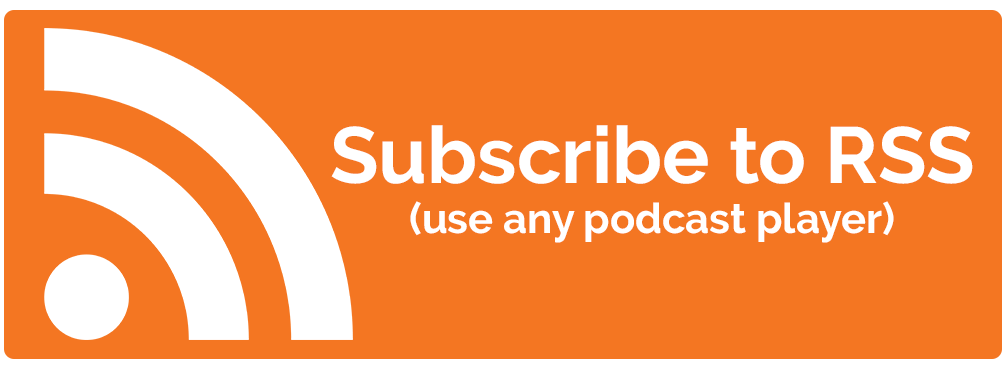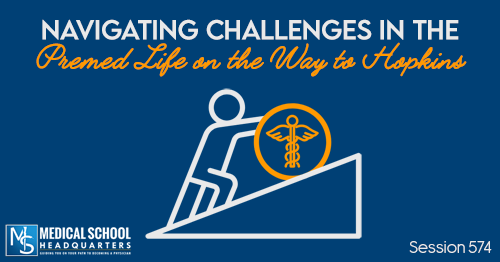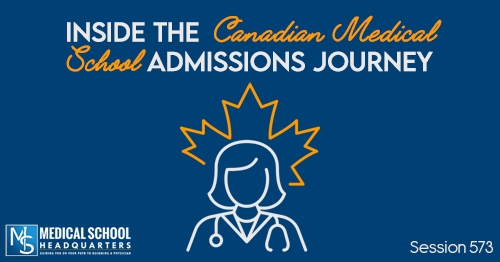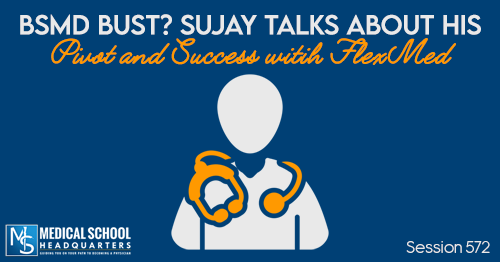Apple Podcasts | Google Podcasts
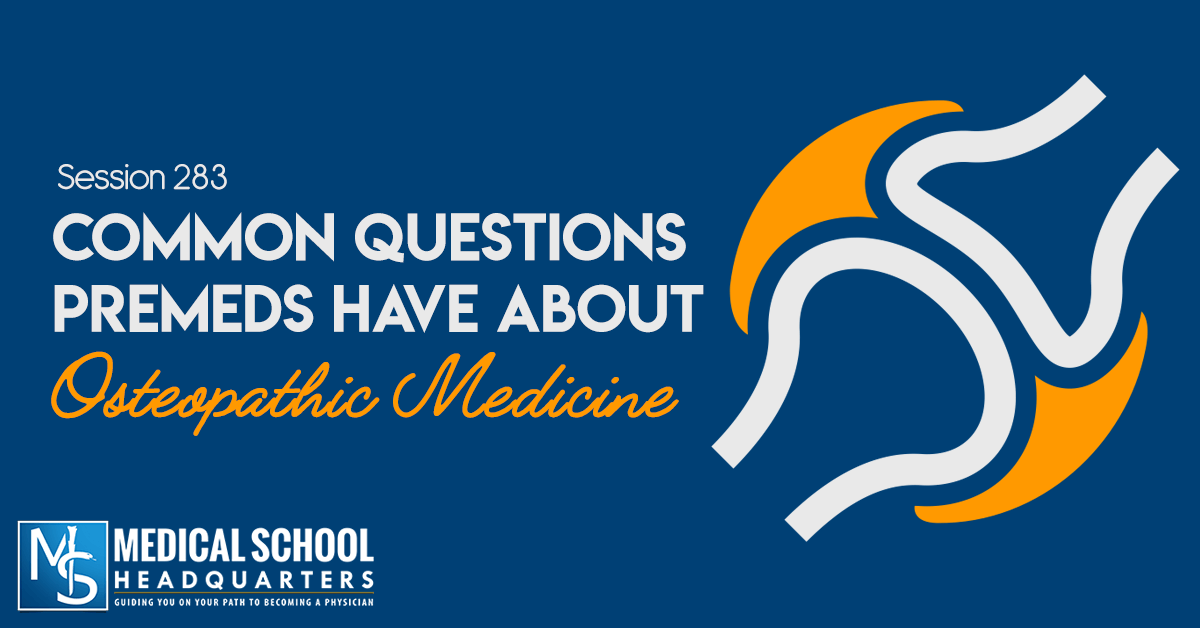
Session 283
Today, I speak with Dr. William “Bill” Mayo, the President-Elect of the American Osteopathic Association (AOA) and a practicing ophthalmologist. He graduated from medical school in 1981 from Kansas City University of Medicine and Biomedical Sciences College of Osteopathic Medicine or also known as KCCOM. He shares things about osteopathic medicine – the merger, dealing with the stigma, residency, exposure, and so much more!
In 2017, I published The Premed Playbook: Guide to the Medical School Interview, which has been well-received by students. This year, we are releasing the second published book in the series called, The Premed Playbook: Guide to the MCAT. Visit the MCATbook.com to get notified. The Premed Playbook: Guide to the Medical School Personal Statement will also be out later this year. Check out personalstatementbook.com to get notified too or pre-order them now on Amazon and Barnes and Noble.
[03:20] Realizing His Calling
Having a father who was a doctor, Bill’s mother died when he was three so he practically grew up seeing what his father was doing at the hospital. Then his father died when he was 17, reason enough for him not to do really well in school at that time but did well afterwards. Because of this, the admissions committee didn’t really look at his application as favorably as he would have wanted. So he asked for a help from a doctor his family knew who helped him get connected with an osteopathic school. At that time, he didn’t know what an osteopathic medical school was.
When he did his interview, the osteopathic school accepted him and he came to appreciate the humanistic approach of osteopathic medicine. Except for the manipulation part, Bill saw this in the way his dad approached his patients. As a result, he became an advocate for that approach to medicine due to his experience.
[Tweet “”I really came to appreciate the humanistic approach, the holistic approach of osteopathic medicine. They’re really approaching body, mind, and spirit.” https://medicalschoolhq.net/pmy-283-common-questions-premeds-have-about-osteopathic-medicine/”]
[09:10] An Interest in Ophthalmology
During his senior year in medical school, he did an elective in ophthalmology to be a better family physician and then he fell in love with it. He did try the ENT and liked the microsurgery but much of it didn’t really appeal to him. As with ophthalmology, he saw some opportunities to create relationships for better patient care. In short, he fell in love with the field in 1980.
[10:55] DO Then and Now
Bill had an ACGME residency which was outside the norm at that time. He looked at residencies in his area and ended up liking the residency program at the University of Mississippi. He knew they didn’t know what a DO was before as they never had one. But he also believed his education had the quality and caliber as their students. So he was able to arrange for an elective rotation for two weeks. During that time, he was really assessed for his knowledge. Then the department chairman called him in the end telling him he could have a spot if he wanted it out of 140 people who applied for four spots. He got one of those four and he was the only DO out of the whole bunch. Bill believed in his education and so he stresses that he was even able to do it a long time ago, much more so now.
[Tweet “”One in four medical students today is an osteopathic medical student.” https://medicalschoolhq.net/pmy-283-common-questions-premeds-have-about-osteopathic-medicine/”]
At the end of the day, it’s all about you, who you are as a student, what you’ve accomplished, how well you’ve done in terms of your grades, boards, and your elective rotations.
[13:45] The Roles of a President-Elect in AOA
As the President-Elect and the President, they lead the Board of Trustees of the AOA. They implement the policies that are informed by resolutions from their house of delegates.
The American Osteopathic Association and the American Medical Association each has a House of Delegates. made of representatives from each of the states as well as the specialties. They set the policy for what they believe in and what they want to support. It’s then the role of the President-Elect and the Board of Trustees to carry it out. They also serve to address issues in between Houses of Delegates.
Their role also entails a lot of traveling, having to go to Washington, D.C. to testify and advocate for certain causes. They also visit state societies and specialty societies, as well as medical schools to make sure there is clear communication and ensure they’re listening to what’s going on.
As president, he appoints people to COCA or the Committee on College Accreditation for Osteopathic Medical Schools (the equivalent of LCME for MD programs). Both the COCA and LCME have the deaning authority from the US Department of Education to basically manage the osteopathic or allopathic medical schools.
Once the people are on COCA, the American Osteopathic Association has an arm’s length relationship with it. This said, they cannot dictate to them what they will do. They can testify to COCA about the AOA would like to see but it’s up to COCA to decide.
[17:12] What They’re Looking for in Applicants
In general, their profession looks for that holistic individual. Bill also stresses that you don’t have to have the perfect numbers to be a good doctor.
[Tweet “”You don’t have to have a perfect MCAT and a 4.0 to be a good doctor.” https://medicalschoolhq.net/pmy-283-common-questions-premeds-have-about-osteopathic-medicine/”]
There is this misconception that if you don’t have good enough scores, then you just apply to DO schools. Bill disagrees and explains that it really depends on the individual. You could have the best numbers but you may still not be fit to be a DO. You may have the credentials, but Bill says, it’s not what I look at people when he writes a letter of recommendation. Instead, he looks at the person.
That being said, you’ve got to have a certain level of grades or a certain level of MCAT to feel like you can make it through the rigors of medical school and your COMLEX or USMLE test to be able to get a license to practice medicine. Once you get past those barriers, they’re now looking for good people.
[21:00] Haven’t Heard of Osteopathic Medicine?
For students who have no prior knowledge of osteopathic medicine, just go to the AOA’s website and look up Find Your DO. You can type in a ZIP code or a city to find DOs in that area. Then comes your challenge of cold calling and asking them if you could come shadow them to see what it’s like. Then out of that can grow a letter of recommendation.
[22:30] Removing the Stigma Against Osteopathic Students
Prior to July 1, 2015, there were separate osteopathic residencies that only DOs could get and there were ACGME residencies that both DOs and MDs could get. In this regard, AOA and the AACOM had an understanding with the ACGME, the larger group of residency programs. They agreed that over a certain period, they were going to create a single system of residency programs.
[Tweet “”From a practice standpoint, we’re viewed as equivalent. There’s no discrimination there.” https://medicalschoolhq.net/pmy-283-common-questions-premeds-have-about-osteopathic-medicine/”]
They’re migrating all of the osteopathic residency programs into the ACGME system, which was made of five separate organizations. Now, it has become seven, with the addition of the AOA and AACOM.
Each group has four representatives on the board that runs ACGME. In addition, they have the residency review committee. It’s made of specialists in that particular field that review and approve all the residency programs in the country.
Every residency review committee that had osteopathic residences now has DOs. So you’ve got MDs and DOs in the room, no matter which room you’re in. They’re all there working.
There are some program directors that may, for whatever reason, have given more preference to one over the other. But they see these barriers have fallen down over the years.
The profession has actually been growing so much in the last 30 years but the public just wasn’t aware of it. So they’ve actually started a brand campaign over three years ago to get the name out, which they continue to do in the hope of becoming a household word.
[Tweet “”We actually started a brand campaign over three years ago to get the name out, just what osteopathic medicine is, of what we do, so that we are much more known now. We are continuing that as well so we are becoming more of a household word.” https://medicalschoolhq.net/pmy-283-common-questions-premeds-have-about-osteopathic-medicine/”]
[26:30] Why Even Have Osteopathic Medical Schools?
Since they will be merging anyway, I raised this question of why not convert every medical school into an MD medical school and have OMM as a Fellowship. Bill explains that osteopathic medicine has offered something very distinctive with their approach to the patient.
A Brief History
When osteopathic medicine started by an MD, Andrew Taylor Still, there were no antibiotics. Medicine was very different and they used leeches in blood letting patients. He came up with the osteopathic manipulative techniques to enhance the medical care of the day. And when he couldn’t get the allopathic medical schools to add to the curriculum, he started his own school. He looked at the body’s natural ability to heal itself and how to enhance that and look at the patient at a holistic approach.
That being said, this is still something they do more so than the average allopathic medical school does. If anything, they’d like to see all of medicine as holistic like they are.
The Empathy Study
Moreover, Bill mentions the Empathy Study originally done in the Cleveland Clinic. They were comparing the empathy levels of osteopathic medical students versus allopathic medical students. They found there was more empathy among osteopathic medical students than the allopathic medical students.
Another longitudinal study is using almost all of the DO schools and several MD schools, looking longitudinally to see the long term effect on the students in terms of empathy.
[31:25] What Students Should Be Worried About with All the Changes Coming
Bill explains that students need to be realistic whether you’re going to be a DO or an MD. Be realistic about your future practice options. If you’re thinking about a high demand specialty like Dermatology and if you’re not near the top of your class and have very good board scores, the odds of getting in wouldn’t be as good. It doesn’t mean you won’t, but it means you really have to work hard and perform well to get considered. But there’s still that point of selling yourself in audition rotations. And if you get that opportunity, it makes a world of difference.
[Tweet “”There’s still the point of ‘selling yourself’ in audition rotations because if you get that opportunity, that makes a world of difference.” https://medicalschoolhq.net/pmy-283-common-questions-premeds-have-about-osteopathic-medicine/”]
However, this is not any different than an MD who has poor board scores that wants a competitive specialty. At the end of the day, it’s about you.
Moreover, what I was initially concerned about is if a weak DO student goes to osteopathic medical school and doesn’t go too well. Then at the end of the day, they’re applying to a relatively easy, non competitive osteopathic residency. But now with the single accreditation, the MDs can also apply to that residency program as well as the international MDs. So what may have been a shielded spot for a weaker DO student is now going to struggle. Again, it all comes down to the individual student but these are the students that are going to be the most affected.
[34:00] DO’s Complete Transition by 2020
Bill explains that each year, there are some students, whether MD or DO, that just don’t match for whatever reason. So they ended up having to try to get to match the next year which would even be more challenging. But 98% of DOs matched. And of the osteopathic residencies that were traditionally osteopathic residencies that are now transitioning, they already have 69% that have transitioned over. They’re either accredited or pre-accredited. By July 1, 2020, everybody should be accredited, metric the use every year. And over the last 10 years, 44 programs closed on average per year. If they didn’t have residents matching for three years, they go away. And this trend has been the same since 2015, with a total of 119 programs closed. All this being said, they expect over 90% to transition. And looking at different specialties for instance, say for anesthesiology, over 72% of their Anesthesiology residencies are already accredited by the ACGME and over 80% of their Pediatric residencies.
[36:50] Canadian Residencies: Spreading the DO Love in Canada
A lot of students in Canada look to come to the US for medical school. The feedback they get for residency if they want to go back to Canada is that osteopathic students are less competitive than even Caribbean MD students.
Bill says that the AOA’s legal counsel has worked with the Canadian Osteopathic Association where each of their provinces can have different rules as opposed to a national standard. In this regard, AOA has been assisting them to get the recognition. In fact, many Canadian stay in the states and do their residencies and want to go back to Canada to practice.
[38:40] Bill’s Final Words of Wisdom
Bill’s two cents for those wanting to be a physician is that if you want to go into this, then your goal is to help people. If you have a servant’s heart, osteopathic is a great field to look into. You’re there to serve your fellowmen. By and large, both DOs and MDs do a good job at that.
[39:30] Last Thoughts
The goal of this specific episode is to try to reduce the amount of negativity among the premed world towards osteopathic schools. The general consensus out there among physicians is that there’s no difference. Among premed students, DOs are going to osteopathic medical schools only for students who can’t get into an MD school. Or that applying to DO school is only something you should do when you don’t have good enough GPA or MCAT score. And this is not the case.
If you want to be a great physician, apply to MD or DO schools. Osteopathic schools, apparently, start students earlier with learning that holistic philosophy of treating patients – mind, body, and spirit.
Links:
The Premed Playbook: Guide to the Medical School Interview
Empathy Study in Cleveland Clinic
COCA or the Committee on College Accreditation for Osteopathic Medical Schools
Get the Podcast Free!
Leave us a Review and Rating!
Just like Yelp reviews or IMDB ratings help you choose your next restaurant or movie, leaving a 5 star rating and/or a written review is very valuable to The Premed Years. It allows us to be able to share our information with more people than ever before.
I am so incredibly thankful to those who have recently gone into our listing in iTunes to provide a five start rating and a written review of The Premed Years.
Subscribe and Download
iOS/Mac/Windows – You can subscribe to the show in iTunes. Or you could manually add the RSS feed to your aggregator.
Android/Mac/Windows – You can download DoubleTwist and use that to manage all of our past and future episodes
Please help us spread the word!
If you like the show, will you please take a moment to leave a comment on iTunes? This really helps us get the word out!



